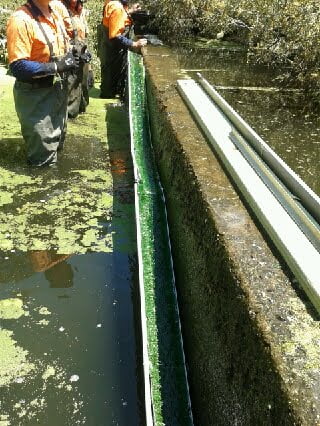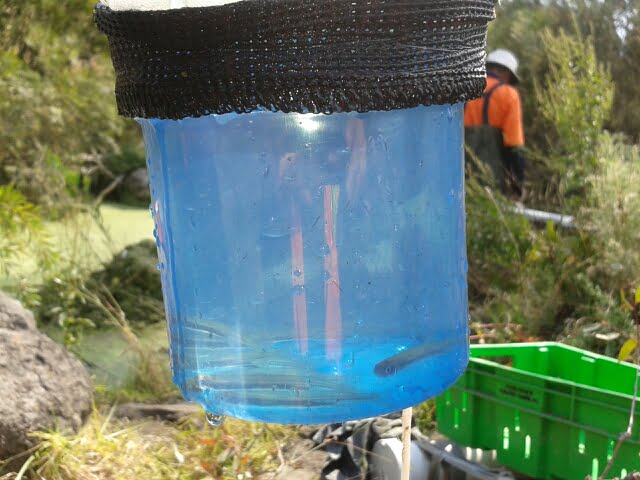On the Werribee River at Bungie’s Hole, fish passage was improved for small bodied fish with the use of a low–cost gutter style fish ladder. Fish passage at Bungie’s Hole had been impeded due to the existence of a series of long standing weirs. Conventional solutions were not possible at this site due to highly restricted access for machinery. So, it was decided to adapt a New Zealand based design (Baker C. F & Boubee J. A. T. (2005). Upstream passage of inanga Galaxias maculatus and redfin bullies Gobiomorphus huttoni over artificial ramps. Journal of Fish Biology 69, 668-681.) which had been used successfully to pass our target species, Common Galaxias ( Galaxias maculatus).
Approach
Dan Borg and Joe Caiafa workshopped adaptations and decided on the use of guttering material fitted with synthetic grass on its base. Often fish passage is oriented with flow, in this case however it runs along the weir wall without loss of functionality. A small notch was made in the weir wall to ensure water flow is available to enter the fish way at typical base flow water levels. The fish passage consists of a top resting pool, two lengths of ~2m of guttering at an incline of 15 degree, broken up by a second central resting pool. The fish way entrance is located near an existing attractant flow, with leeway for water levels to drop a further 10cm before the fish way entrance is out of water.

The synthetic grass breaks up the laminar flow inside the fish way and provided refuge and grip for climbing. Fish passage assessments on site confirmed that Common Galaxias are able to navigate the new fish way. One trial consisted of releasing ~40 G. maculatus at the central resting pool. After 30 minutes, 11 had exited the fishway. Of a further 50 Galaxias maculatus released within the fishway close to the entrance, 20 exited the fishway within 30 minutes. While the ability of the fishway to attract fish to the entrance remains untested, these are very promising initial results.

So what?
The success of this prototype means we now have another way to enable fish passage. Benefits to this approach include:
- Low cost
- Quick assembly ( one day to fit in this case)
- Enables fish passage at previously inaccessible locations
- Internal capacity building
- Broadens our minds to include non- traditional building materials and approached for problem solving
- Provides greater stewardship of our natural assets.
If you would like further detail on this project or other fish related matters, please don’t hesitate to contact Monica Tewman at Melbourne Water on (03) 9679 6648.




